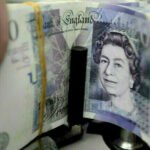- GBP/USD trades in positive territory above 1.3200 on Tuesday.
- The positive shift seen in risk mood helps the pair hold its ground.
- The technical outlook continues to show overbought conditions.
Following Monday’s short-lasting downward correction, GBP/USD regained its traction early Tuesday and was last seen trading at its highest level since March 2022 near 1.3230.
British Pound PRICE This week
The table below shows the percentage change of British Pound (GBP) against listed major currencies this week. British Pound was the strongest against the Japanese Yen.
| USD | EUR | GBP | JPY | CAD | AUD | NZD | CHF | |
|---|---|---|---|---|---|---|---|---|
| USD | 0.11% | -0.21% | 0.39% | -0.33% | 0.15% | 0.00% | -0.16% | |
| EUR | -0.11% | -0.39% | 0.28% | -0.43% | -0.05% | -0.10% | -0.26% | |
| GBP | 0.21% | 0.39% | 0.56% | -0.11% | 0.33% | 0.22% | 0.07% | |
| JPY | -0.39% | -0.28% | -0.56% | -0.70% | -0.15% | -0.16% | -0.46% | |
| CAD | 0.33% | 0.43% | 0.11% | 0.70% | 0.48% | 0.37% | 0.17% | |
| AUD | -0.15% | 0.05% | -0.33% | 0.15% | -0.48% | -0.06% | -0.21% | |
| NZD | -0.00% | 0.10% | -0.22% | 0.16% | -0.37% | 0.06% | -0.16% | |
| CHF | 0.16% | 0.26% | -0.07% | 0.46% | -0.17% | 0.21% | 0.16% |
The heat map shows percentage changes of major currencies against each other. The base currency is picked from the left column, while the quote currency is picked from the top row. For example, if you pick the British Pound from the left column and move along the horizontal line to the US Dollar, the percentage change displayed in the box will represent GBP (base)/USD (quote).
The positive shift seen in risk sentiment on easing fears over a deepening conflict in the Middle East doesn’t allow the US Dollar (USD) to build on Monday’s rebound and allows GBP/USD to stretch higher in the European morning. At the time of press, the UK’s FTSE 100 Index was up 0.6% on the day and US stock index futures were rising between 0.1% and 0.25%, reflecting the improving market mood.
In the second half of the day, June Housing Price Index and August Conference Board Consumer Confidence Index data will be featured in the US economic docket. Investors are likely to ignore these releases and remain focused on risk perception.
A bullish opening in Wall Street, followed by another bout of risk rally, could force the USD to stay on the back foot and leave the door open for another leg higher in GBP/USD.
GBP/USD Technical Analysis
Despite Monday’s pullback, the Relative Strength Index (RSI) indicator on the 4-hour chart stays well above 70, suggesting that GBP/USD is still technically overbought. On the upside, 1.3270 (upper limit of the ascending regression channel) aligns as next resistance before 1.3300.
First support for GBP/USD is located at 1.3200 (psychological level, static level, mid-point of the ascending channel). If the pair makes a daily close below this level and starts using it as resistance, 1.3160 (lower limit of the ascending channel) could be seen as next support before 1.3100 (psychological level, static level).
Pound Sterling FAQs
The Pound Sterling (GBP) is the oldest currency in the world (886 AD) and the official currency of the United Kingdom. It is the fourth most traded unit for foreign exchange (FX) in the world, accounting for 12% of all transactions, averaging $630 billion a day, according to 2022 data. Its key trading pairs are GBP/USD, aka ‘Cable’, which accounts for 11% of FX, GBP/JPY, or the ‘Dragon’ as it is known by traders (3%), and EUR/GBP (2%). The Pound Sterling is issued by the Bank of England (BoE).
The single most important factor influencing the value of the Pound Sterling is monetary policy decided by the Bank of England. The BoE bases its decisions on whether it has achieved its primary goal of “price stability” – a steady inflation rate of around 2%. Its primary tool for achieving this is the adjustment of interest rates. When inflation is too high, the BoE will try to rein it in by raising interest rates, making it more expensive for people and businesses to access credit. This is generally positive for GBP, as higher interest rates make the UK a more attractive place for global investors to park their money. When inflation falls too low it is a sign economic growth is slowing. In this scenario, the BoE will consider lowering interest rates to cheapen credit so businesses will borrow more to invest in growth-generating projects.
Data releases gauge the health of the economy and can impact the value of the Pound Sterling. Indicators such as GDP, Manufacturing and Services PMIs, and employment can all influence the direction of the GBP. A strong economy is good for Sterling. Not only does it attract more foreign investment but it may encourage the BoE to put up interest rates, which will directly strengthen GBP. Otherwise, if economic data is weak, the Pound Sterling is likely to fall.
Another significant data release for the Pound Sterling is the Trade Balance. This indicator measures the difference between what a country earns from its exports and what it spends on imports over a given period. If a country produces highly sought-after exports, its currency will benefit purely from the extra demand created from foreign buyers seeking to purchase these goods. Therefore, a positive net Trade Balance strengthens a currency and vice versa for a negative balance.
















